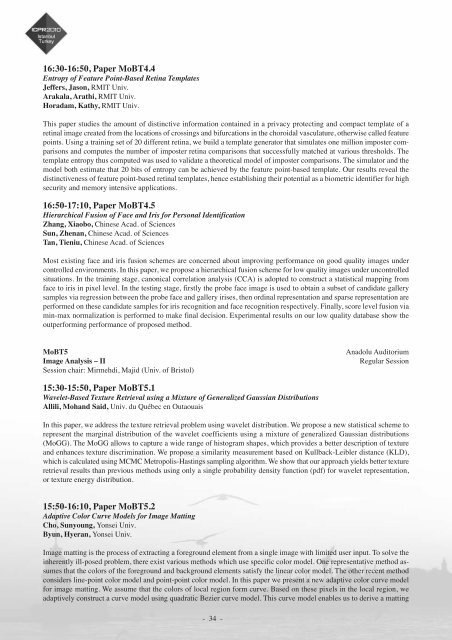Abstract book (pdf) - ICPR 2010
Abstract book (pdf) - ICPR 2010
Abstract book (pdf) - ICPR 2010
- TAGS
- abstract
- icpr
- icpr2010.org
Create successful ePaper yourself
Turn your PDF publications into a flip-book with our unique Google optimized e-Paper software.
16:30-16:50, Paper MoBT4.4<br />
Entropy of Feature Point-Based Retina Templates<br />
Jeffers, Jason, RMIT Univ.<br />
Arakala, Arathi, RMIT Univ.<br />
Horadam, Kathy, RMIT Univ.<br />
This paper studies the amount of distinctive information contained in a privacy protecting and compact template of a<br />
retinal image created from the locations of crossings and bifurcations in the choroidal vasculature, otherwise called feature<br />
points. Using a training set of 20 different retina, we build a template generator that simulates one million imposter comparisons<br />
and computes the number of imposter retina comparisons that successfully matched at various thresholds. The<br />
template entropy thus computed was used to validate a theoretical model of imposter comparisons. The simulator and the<br />
model both estimate that 20 bits of entropy can be achieved by the feature point-based template. Our results reveal the<br />
distinctiveness of feature point-based retinal templates, hence establishing their potential as a biometric identifier for high<br />
security and memory intensive applications.<br />
16:50-17:10, Paper MoBT4.5<br />
Hierarchical Fusion of Face and Iris for Personal Identification<br />
Zhang, Xiaobo, Chinese Acad. of Sciences<br />
Sun, Zhenan, Chinese Acad. of Sciences<br />
Tan, Tieniu, Chinese Acad. of Sciences<br />
Most existing face and iris fusion schemes are concerned about improving performance on good quality images under<br />
controlled environments. In this paper, we propose a hierarchical fusion scheme for low quality images under uncontrolled<br />
situations. In the training stage, canonical correlation analysis (CCA) is adopted to construct a statistical mapping from<br />
face to iris in pixel level. In the testing stage, firstly the probe face image is used to obtain a subset of candidate gallery<br />
samples via regression between the probe face and gallery irises, then ordinal representation and sparse representation are<br />
performed on these candidate samples for iris recognition and face recognition respectively. Finally, score level fusion via<br />
min-max normalization is performed to make final decision. Experimental results on our low quality database show the<br />
outperforming performance of proposed method.<br />
MoBT5 Anadolu Auditorium<br />
Image Analysis – II Regular Session<br />
Session chair: Mirmehdi, Majid (Univ. of Bristol)<br />
15:30-15:50, Paper MoBT5.1<br />
Wavelet-Based Texture Retrieval using a Mixture of Generalized Gaussian Distributions<br />
Allili, Mohand Said, Univ. du Québec en Outaouais<br />
In this paper, we address the texture retrieval problem using wavelet distribution. We propose a new statistical scheme to<br />
represent the marginal distribution of the wavelet coefficients using a mixture of generalized Gaussian distributions<br />
(MoGG). The MoGG allows to capture a wide range of histogram shapes, which provides a better description of texture<br />
and enhances texture discrimination. We propose a similarity measurement based on Kullback-Leibler distance (KLD),<br />
which is calculated using MCMC Metropolis-Hastings sampling algorithm. We show that our approach yields better texture<br />
retrieval results than previous methods using only a single probability density function (<strong>pdf</strong>) for wavelet representation,<br />
or texture energy distribution.<br />
15:50-16:10, Paper MoBT5.2<br />
Adaptive Color Curve Models for Image Matting<br />
Cho, Sunyoung, Yonsei Univ.<br />
Byun, Hyeran, Yonsei Univ.<br />
Image matting is the process of extracting a foreground element from a single image with limited user input. To solve the<br />
inherently ill-posed problem, there exist various methods which use specific color model. One representative method assumes<br />
that the colors of the foreground and background elements satisfy the linear color model. The other recent method<br />
considers line-point color model and point-point color model. In this paper we present a new adaptive color curve model<br />
for image matting. We assume that the colors of local region form curve. Based on these pixels in the local region, we<br />
adaptively construct a curve model using quadratic Bezier curve model. This curve model enables us to derive a matting<br />
- 34 -



